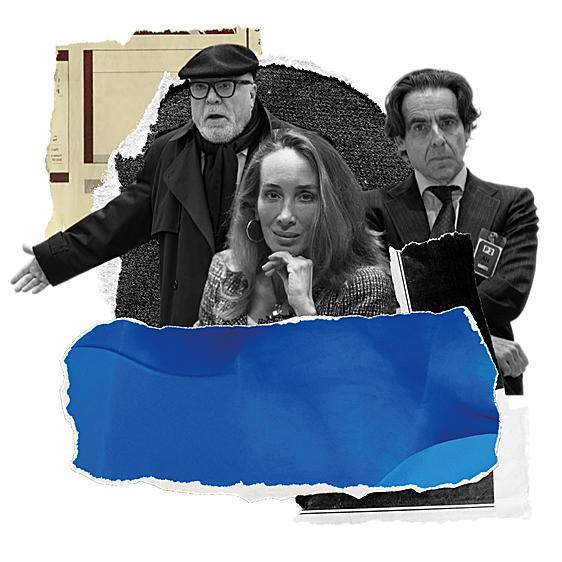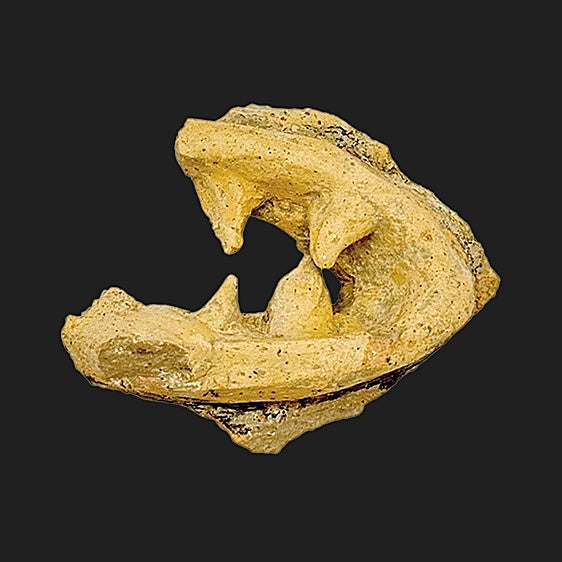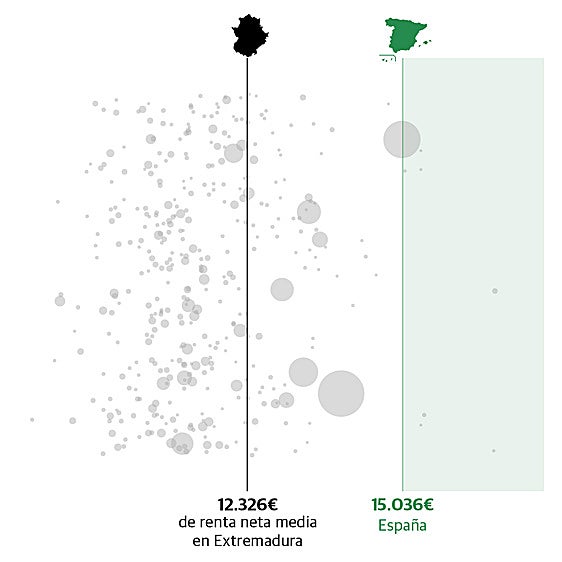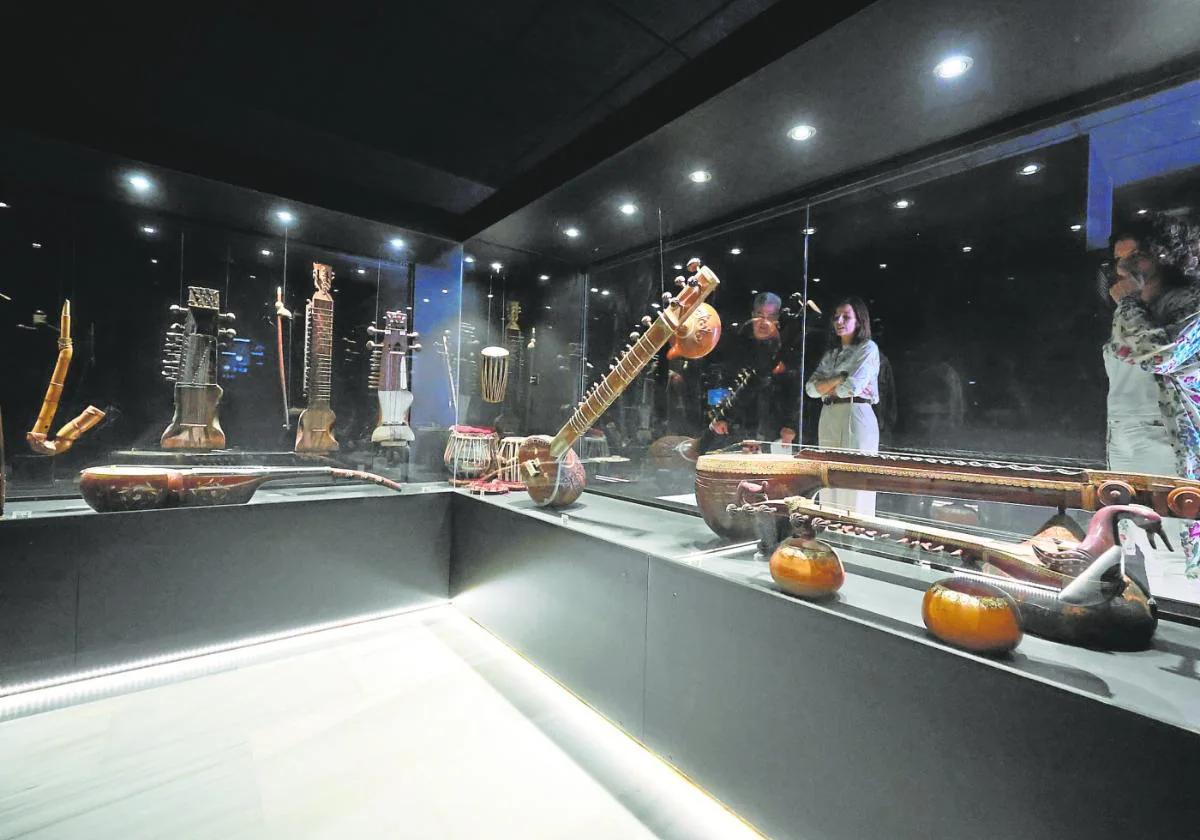Twenty years of a museum where touching (and playing) the exhibits is allowed
MIMMA. The Interactive Museum of Music in Malaga has just celebrated two decades of revolutionising a trip to a museum by inviting more than 1.2 million visitors to play a guitar, drums or a flamenco box
Francisco Griñán
Malaga
Sábado, 27 de mayo 2023, 08:06
'I'm just a businessman." Said like that, with no fanfare, this statement can sound like false modesty. Not so. Miguel Ángel Piédrola Orta means it. His fashion stores - up to ten with the legendary Río de la Plata shop leading the way - have dressed several generations of Malaga people for both weddings and everyday life. What few knew, even in his family, is that he was working hard to feed and clothe his other passion. Since buying his first instrument, a bandurria (a plucked chordophone, similar to a mandolin) to play with his tuna (a musical group of university students playing traditional instruments) more than 70 years ago, this 'merchant' has not stopped buying pianos, guitars and all kinds of musical curiosities. He has managed to collect more than a thousand pieces from all over the world, making this one of the best collections in Spain.
"I never thought of a museum until my friends talked to me and urged me on," he says, listing illustrious names from the world of classical music in Malaga, such as Gonzalo Martín Tenllado, Manuel del Campo, Francisco de Galvéz, José Miguel Fernández Pelegrina and Toni Romero. And so he went about turning their encouragement into his dream.
-
Pianos by López-Griffo
-
In the 19th century, the bourgeois families of Malaga joined the trend of having a piano in the home as a sign of distinction This led to the development of three local firms, led by the pioneering Adolfo Montargón and his Los Mártires workshop. They continued into the 20th century under his disciple Juan López, who teamed up with Griffo, and together they opened shops in Seville, Granada and Almeria. Juan López's piano on display in the museum was the first instrument in the collection of Miguel Ángel Piédrola.
-
'Chancletófono'
-
Manufactured by the museum itself, this instrument produces music with plastic PVC tubes and the sole of a flip-flop that, depending on the pipe it strikes, produces a note This instrument is one of the 'please play' exhibits. It is located in the first red room of MIMMA where visitors can (and must) test the sound of the musical devices they have just viewed. In this dedicated space the flip-flop is used, along with other 'toys', to illustrate the fundamentals of physics, such as sound waves, frequency or vibration.
-
Guidonian hand
-
It is not an instrument, yet it is one of the most popular parts of the museum. This installation reproduces the hand of the visionary Guido D'Arezzo, who, in the 11th century, not only named all musical notes as we know them today, but also used his own hand to guide the singing of the different members of his choir. He divided the phalanges of each finger to assign them a note, then he could simply point to each part to guide the singers. This piece is also interactive.
-
Flamenco rhythm machine
-
'Her' name is 'Carmen' and there are only three specimens in the world. This instrument is capable of creating the sound of flamenco shoes tapping out a beat, playing the equivalent of 20 dancers at once. This rarity, created by Ignacio Rodríguez, is capable of reproducing the rhythms of the different flamenco styles. A previous model, including two wooden feet, is also on display.
-
Harp.
-
This instrument made by the prestigious French maker Érard is dated 1819 and was made for the French royals as indicated by a plaque on the top. The harp was donated to the MIMMA in 2014 by English writer Marion Leigh, a Costa del Sol resident, who explained that the piece was found in a barn in Pennsylvania (USA) in very poor condition, then restored. A round trip from France to the US, then back to Europe to be exhibited in Malaga.
-
Ocarina
-
The oldest exhibit in the museum. From pre-Colombian times, it was found in a guaca or tomb, five metres down, in the Guachicono River (Colombia). These wind instruments arrived in Europe after their discovery by travellers and, due to their size, were regarded more as a toy. It was donated to the museum in 1981 by the Colombian Ambassador.
-
Gramophone
-
Recorded music streaming through Spotify or any other music app has its roots in the phonograph, closely followed by Emile Berliner's gramophone at the end of the 19th century, which made great advances in the recording and reproduction of sound. The gramophone could record sounds onto a flat disc made of hard rubber, from which thousands of copies could be made. It enabled the user to make their own recordings, which was a revolution in its time and part of its success.
-
Synthesiser
-
The use of frequency oscillators for sound, since the 1920s, marks the beginnings of electronic music By the 1950s the first studios to create electronic music were appearing, alongside the first synthesisers that controlled tones via keyboards, such as the RCA Mark II (1957). Next came Buchla synthesisers, which were among the first to be commercialised in 1966, reaching their height of popularity in the '80s and '90s with different versions for home use.
It took a while to get off the ground, with a few hiccups in the 1990s, but that visionary idea is now a 20-year-old reality. In this time the Interactive Museum of Music (MIMMA) has become one of the pioneers of cultural promotion in Malaga, together with the Picasso Museum and the CAC. Uniquely, it is also known for introducing the radical concept of inviting the public to 'please touch' the exhibits.
In fact, the motto in Spanish 'Se ruega tocar' goes a lot further in this case than telling visitors they can touch the exhibits, as 'tocar' also means to play an instrument. And you only need to walk through the heart of the museum in the remodelled Palacio del Conde de las Navas to see how the slogan sets the tone for the visits. In one of the red rooms (these have playable instruments available) a boy bangs on a keyboard, his classmate next to him sings a popular song and the rest of their classmates fall about laughing.
"This was my son's big idea. I would have set it up for people just to look, and that's that, but he knew that something else was needed, that a music museum had to be interactive so that visitors could experience it and enjoy it," says this collector, remembering his son, Miguel Ángel Piédrola Lluch, founder, creator and director of MIMMA until his untimely death just over a year ago. They teamed up to embark on this adventure together in the original, but rather unworldly, exhibition space in the car park under the city's Plaza de la Marina. An underground museum with car fumes? The only positive was the easy parking.
"We took the plunge and I spent a fortune fixing it up; well no, it was not the best place, but we were just so keen...", recalls Piédrola senior, who followed to the letter the teachings of his bedside reading, How To Get What You Want, by Orison Swett Marden. The truth is that that first museum space, although small and underground, provided the origins of something unique which, on 7 May, celebrated 20 years of success. The figures speak for themselves: 1,245,000 people have experienced the look, listen, touch and play philosophy of this temple to music.
This is a double anniversary as 2023 also marks the 10th year since the MIMMA moved from that car park to the well-lit, remodelled Conde de las Navas palace, on the corner of Calle Beatas and Calle Cárcer - a better space for viewing and listening to the collection as though in a great orchestra.
'Please play'
"We were looking for a new location and it was once again Miguel Ángel senior who saw this building being demolished and spoke with the city council, which acquired it to restore it for the MIMMA to use," explains Marta Izquierdo, who has been at the museum since its foundation, but has stepped into the limelight as director following the death of her husband and founder of the museum, Miguel Ángel Piédrola Lluch.
"Miguel Ángel's obsession was for this museum to be adapted to the general public and not only for music enthusiasts, but also for families and children, who in fact make up most visitors - 65%," says the new director as she accompanies us on a guided tour.
The atmosphere proves her right. It's Monday, the day when most museums are closed, but this palace of music is open and schoolchildren are discovering instruments from all over the world in the black rooms that house the main collection, then trying out how they sound in the red 'please play' rooms.
"Sometimes musical people meet up here and they put on an improvised, never to be repeated, concert," adds Marta who, after our photographer insists, sits on a flamenco box to drum out a beat. She says that the museum is in her heart, but that playing music is not her forte. Despite this, she strikes up a rhythm on the box. She feels the instrument is kind to newcomers as, with just a little practice, one can keep the beat. "Look at the king, how well he did in Cadiz when he played it," she says, adding that the MIMMA is "a museum of music, not just instruments".
This opportunity to experience and feel a melody is what makes this place so unique. It has now recovered from the pandemic, hit doubly hard not only due to the general closure of all museums, but also for the additional restriction, once reopened, of visitors not being allowed to touch anything.
"All cultural activity was affected, but additionally we couldn't make use of our motto 'se ruega tocar' that had made us different, so we had to reinvent ourselves. We opted for virtual content, recordings and streaming activities that kept us in touch with our visitors and music fans," she says.
Greeting real visitors is now back to full capacity, with meetings, talks, flamenco performances coinciding with visits by cruise passengers and other groups of foreigners (still open to all) and even a European musical entrepreneurship programme in collaboration with the Paideia Foundation and the Spanish government. "We have never stopped and for that reason they sometimes tell us that we're not just the interactive, but the hyperactive museum of music," says Marta Izquierdo with a smile.
Turning to visitor data, the museum ended 2022 with a total of 73,315 visitors, which represents the recovery of more than 64% of the total for 2019 (113,827).
"We thought that the recovery was going to slow down, but 2023 is a bit scary because of how well it has started. We don't stop. January and February have been the best in our history with increases of 10% and 13% respectively, compared to the same months of 2019, which were the best," she points out, as we reach an unused space, once an old shop, where the MIMMA has expansion plans. Thus, following the closure of this space and the relocation of the exit alongside the entrance on Calle Beatas, the museum will gain this area, where it plans to create a mechanical music room with organs, pianolas, musical boxes... and to explore the relationship between music and film and our dependence on recorded and electronic music.
We have returned to the starting point of the tour. On display there is the instrument that Miguel Ángel Piédrola Orta is most fond of, an early 20th century piano made by Juan López from Malaga. It is the instrument from this collector's childhood, from his parents' house. Those piano keys with so much history continue to welcome visitors as they (re-)discover the best-sounding museum in Malaga. And with no one to reproach us if our hands wander over the exhibits.



